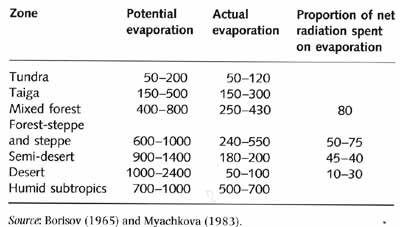Please put an active hyperlink to our site (www.rusnature.info) when you copy the materials from this page
Physical Geography of Northern Eurasia
Climate at Present and in the Historical Past
<<< Precipitation | Physical Geography Index | Droughts and
Associated Climatic Hazards >>>
Evaporation
Strong spatial and seasonal variations in temperature and moisture availability mean
that both potential and actual evaporation vary spatially and temporally. The highest
values of potential evaporation (about 2000 mm a-1) are observed in the deserts
of Central Asia which receive the highest input of solar energy. Potential evaporation
declines northwards reaching approximately 125 mm a-1 in the Siberian Arctic
although topography and water bodies disrupt the latitudinal distribution. Low values
occur in the Far East because of the humid climate and higher cloud cover which lowers the
input of heat (Borisov, 1970). The distribution of actual evaporation, which is controlled
by the availability of both heat and moisture, is different (Table 3.1).

Table 3.1 Average potential and actual evaporation (mm a-1)
and the proportion of net radiation spent on evaporation (%) in different
physical-geographical zones
Deserts exhibit the lowest values of actual evaporation because of the lack of moisture
and likewise low values occur in the tundra zone because of the lack of heat. Actual
evaporation is the highest in the humid subtropics of Transcaucasia. Another maximum
occurs in the mixed forest and forest-steppe zones of the European territory, the Ussuri
basin in the Far East and in Western Siberia. Evaporation occurs between April and October
and annual patterns reflect the distribution of evaporation during the warm season.
Between November and February, actual evaporation is extremely low or virtually zero
across most of Northern Eurasia with the exception of the Black and Caspian Sea regions,
the Barents Sea, and the Pacific Seas. Only by March do monthly evaporation totals reach
10 mm in Central Asia and Transcaucasia as temperature increases and spring rainfall
provides moisture. The spring evaporation patterns are extremely inhomogeneous because
they depend on the presence of snow cover, the amount of snow and the rate of snow melt.
It is the melt water that ensures that there is no soil moisture deficit in spring-early
summer north of the Kiev-Moscow-Tobolsk-Irkutsk line.
<<< Precipitation | Physical Geography Index | Droughts and
Associated Climatic Hazards >>>
|